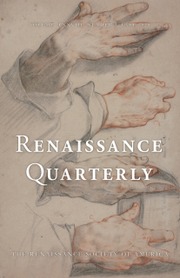Crossref Citations
This article has been cited by the following publications. This list is generated based on data provided by
Crossref.
Barilan, Yechiel Michael
1920.
Jewish Bioethics.
Crawford, T. Hugh
1996.
Imaging the Human Body: Quasi Objects, Quasi Texts, and the Theater of Proof.
PMLA/Publications of the Modern Language Association of America,
Vol. 111,
Issue. 1,
p.
66.
Siraisi, Nancy G.
1997.
Vesalius and the Reading of Galen's Teleology*.
Renaissance Quarterly,
Vol. 50,
Issue. 1,
p.
1.
Weisz, George M.
1997.
THE PAPAL CONTRIBUTION TO THE DEVELOPMENT OF MODERN MEDICINE.
Australian and New Zealand Journal of Surgery,
Vol. 67,
Issue. 7,
p.
472.
Dolan, Frances E.
1999.
Catholicism and Anti-Catholicism in Early Modern English Texts.
p.
218.
Park, Katharine
2002.
The Material Culture of Sex, Procreation, and Marriage in Premodern Europe.
p.
115.
Nurka, Camille
2002.
Postfeminist Autopsies.
Australian Feminist Studies,
Vol. 17,
Issue. 38,
p.
177.
Tait, Clodagh
2002.
Death, Burial and Commemoration in Ireland, 1550–1650.
p.
30.
Moore, Charleen M.
and
Brown, C. Mackenzie
2004.
Gunther von Hagens and Body Worlds part 2: The anatomist as priest and prophet.
The Anatomical Record Part B: The New Anatomist,
Vol. 277B,
Issue. 1,
p.
14.
Greenfield, Matthew
2004.
Christopher Marlowe's Wound Knowledge.
PMLA/Publications of the Modern Language Association of America,
Vol. 119,
Issue. 2,
p.
233.
Mafart, B.
Pelletier, J.‐P.
and
Fixot, M.
2004.
Post‐mortem ablation of the heart: a medieval funerary practice. A case observed at the cemetery of Ganagobie Priory in the French Department of Alpes de Haute Provence.
International Journal of Osteoarchaeology,
Vol. 14,
Issue. 1,
p.
67.
Santing, Catrien
2004.
Cultural Approaches to the History of Medicine.
p.
11.
Sugg, Richard
2004.
Donne and the Uses of Anatomy.
Literature Compass,
Vol. 1,
Issue. 1,
p.
**.
Floyd‐Wilson, Mary
Greenfield, Matthew
Paster, Gail Kern
Pollard, Tanya
Rowe, Katherine
and
Yates, Julian
2005.
Shakespeare and Embodiment: An E‐Conversation.
Literature Compass,
Vol. 2,
Issue. 1,
Achim, Miruna
2005.
Mysteries of the Heart: The Gift of Bishop Fernández de Santa Cruz to the Nuns of Santa Mónica*.
Colonial Latin American Review,
Vol. 14,
Issue. 1,
p.
83.
Strier, Richard
and
Mazzio, Carla
2006.
Two Responses to ‘Shakespeare and Embodiment: An E‐Conversation’.
Literature Compass,
Vol. 3,
Issue. 1,
p.
15.
Findlen, Paula
2006.
The Cambridge History of Science.
p.
272.
Eamon, William
2006.
The Cambridge History of Science.
p.
206.
Strier, Richard
and
Mazzio, Carla
2006.
Two Responses to 'Shakespeare and Embodiment: An E-Conversation'.
Literature Compass,
Vol. 3,
Issue. 1,
p.
15.
Cook, Harold J.
2006.
The Cambridge History of Science.
p.
407.


